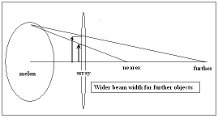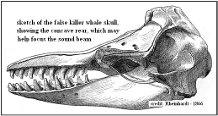Whales and the acoustic squint
Whales strain their ears to see
How whales use SONAR to locate prey in total darkness has fallen to research, says S.Ananthanarayanan.
Toothed whales, which include dolphins, are able to precisely locate and snap up very small fish or other food that come before them, even in deep water where there is hardly any visibility. They use SONAR, or echolocation, of course, but how they achieve
the uncanny accuracy has not been understood. Laura Kloepper from the University of Hawaii, USA, and her PhD adviser, Paul Nachtigall now report in the Journal of Experimental Biology, their finding that dolphin species called the false killer whale (because
of its resemblance) is able to focus and adjust its beam of sound waves, to get the most crisp echoes and the best fix on its target.
Dolphin apparatus
The dolphin creates high pitched, ie, ultrasonic, ‘clicks’, for echolocation from nasal structures in a region called the melon, in its forehead. The sound is emitted by structures of fatty tissue, called monkey lips, which are made to slap together by forcing
air from the lungs – to create the echolocation pulses of sound. The sound waves pass through fatty material in the melon, which minimizes reflection at the contact with water, so that the sound waves pass into the water with the least loss of energy. The
rear portion of the melon is hard bone and is concave, to focus, or direct the sound waves in a beam, like a searchlight.
It has been known that toothed whales (unlike baleen whales, which filter seawater through their teeth to capture prey) are able to adapt the frequency and the intensity of the sound clicks, according to changes in the environment. Beams of sound waves,
or even RADAR beams, become narrower when the radiation is of higher frequency. It was thought that variations in beam width of toothed whale sounds may be related to the frequency alone. But the bony rear surface of the melon is covered with air spaces, whose
pressure and size are variable and do change during emission of clicks, and these could act to focus the beam independent of frequency. The fatty material that fills the melon could also behave like a lens to widen or narrow the beam. The array of muscles
and tendons that surround the melon strongly suggest that this is the case, although actual changes in the echolocation beam, according to need, had not been demonstrated.
Experiment
Kloepper and Nachtigal decided to find out with the help of Kina, a trained and well adapted false killer whale that has lives within the Marine Mammal Research Program at the University of Hawaii. The experimental set up consisted of 2 pens, separated by
an opening like a hoop. Kina was trained to take position in one pen, with her head inside the hoop up to her first fin, and try to locate a specific object placed in the other pen. Line of sight to the object was blocked by a screen that allowed no light
and another screen that was opaque to sound enabled the experiment, with sound waves, to start and stop. Kina was trained to touch a response lever when she spotted the standard target object, or to stay still if she spotted a different object. The standard
object was an aluminium cylinder, about 5 inches long and the other objects were similar cylinders, of lesser and even lesser thickness. Kina was rewarded with a fish every time she identified the object correctly, as the standard or different cylinder. An
array of underwater microphones also picked up the sounds emitted by Kina and recorded the strength of the sound beam at different points, to estimate how narrow or wide the beam was during each echolocation event.

The standard object was one that Kina was able to identify comfortably, during trials, while the cylinders of lesser thickness were ‘difficult’ and ‘more difficult’ targets, as revealed in trials. The experiment was then to get Kina to identify the 3 objects,
randomly presented at different distances, 2.5, 4 and 7 metres, over the period of some weeks. And during the attempts, to record the frequency and spread of the sound beam that Kina used in the effort.
Discovery
The first look at the results showed that beams of higher frequency were narrower in all cases, which is hardly significant because such narrowing or widening is the property of acoustic beams. But what was significant was that the frequencies were not evenly
distributed over different distances and levels of difficulty. Analysis of the beam width at the same frequency and different difficulty levels or at different distances revealed that the changes in beam area did not correlate in all cases to the frequency
alone. It was seen that beam areas decreased for difficult targets and increased for greater distances.
The results are consistent with a tendency to concentrate the beam width, so that there is more reflected information, in the case of a difficult target. Such concentration may be by using a higher frequency, which also leads to better resolution of images.
But statistical analysis was able to distinguish the widening that was because of the change of frequency and to identify a positive widening which was not related to frequency, but came about with increasing distance. Although the beam appeared to widen at
the array which was placed close to Kina, plotting the path of sound waves revealed that the beams that appeared widest at the array were not spreading out but were focused on farthest targets, while narrow beams aught then to be focused at shorter distances.
The results thus showed that Kina was able to adjust both the frequency and the focus of the sound beam so that the maximum energy could be reflected back by the target object, for the best identification.

The results reported are a first confirmation that there is actual and constructive focusing of the sound beam by the dolphin. The anatomy of the animal strongly suggests that the action is by varying reflectivity of the concave cavity behind the source of
sound, by the action of muscles and the pressure of the air sacs. The young false killer whale then learns to use the ability to resolve morsels that drift across its acoustic viewfinder, much like human babies learn to focus and coordinate their eyes to touch
and grasp objects.
[the writer can be contacted at
simplescience@gmail.com]